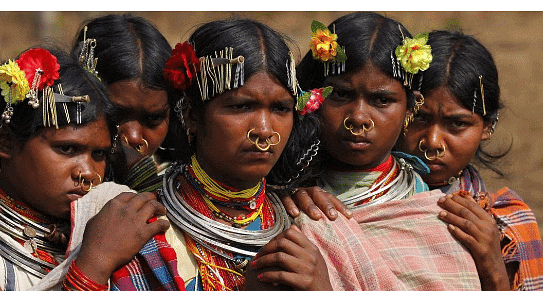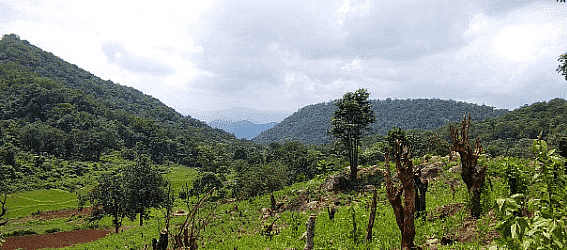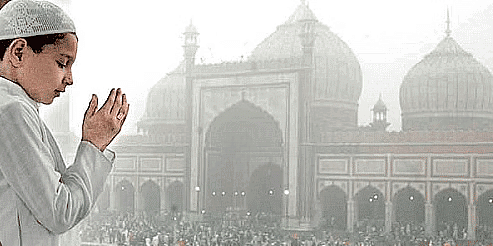Class 8 Civics Chapter 7 Important Question Answers - Understanding Marginalisation
Very Short Answer Type Questions
Q1: How many different Adivasi groups are there in India?
Ans: There are over 500 different Adivasi groups in India.
 AdivasiQ2: Name any four states where Adivasis are in great numbers. [V. Imp.]
AdivasiQ2: Name any four states where Adivasis are in great numbers. [V. Imp.]
Ans: Chhattisgarh, Jharkhand, Madhya Pradesh, and Odisha are four states in India where Adivasis are found in significant numbers.
Q3: How are Adivasi societies most distinctive? Give one point. [V. Imp.]
Ans: Adivasi societies are distinctive primarily due to their social structure:
- They often exhibit very little hierarchy among members.
- This lack of hierarchy sets them apart from communities organised by caste systems or ruled by kings.
Q4: How are Adivasis usually portrayed?
Ans: They are usually portrayed in Stereotypical ways in colourful clothes, headgear and through their dancing.
Q5: What do we usually think about Adivasis?
Ans: We usually think that Adivasis are exotic, primitive and backward.
Q6: What is the population of Adivasis in Assam? [Imp.]
Ans: There are 70 lakhs Adivasis in Assam.
Q7: How is Niyamgiri viewed by Dongarria Konds?
Ans: Dongarria Konds, an Adivasi community, view Niyamgiri as the sacred mountain.
Q8: Why are Muslims considered as a marginalised community in India today?
Ans: It is because in comparison to other communities, they have always been deprived of the benefits of socioeconomic development. Q9: How are Muslims usually identified?
Q9: How are Muslims usually identified?
Ans: Muslims are usually identified by their burqa, long beard and fez.
Q10: Which factor leads to ghettoisation of the Muslim community?
Ans: Social marginalisation of Muslims leads to ghettoisation of this community.
Q11: What is commonly believed about the Muslims?
Ans: It is commonly believed that the Muslims prefer to send their children to Madarsas.
Q12: What reality is brought in light by the Sachar Committee?
Ans: Only 4% of Muslim children are in Madarsas, whereas 66% attend government school and 30% private schools.
Short Answer Type Questions
Q1: What do you know about Adivasis? [Imp.]
Ans:
- The term "Adivasi" means original inhabitant, and they have a close relationship with forests, depending on them for various aspects of life.
- About 8% of India's population is Adivasi, and they are found in states such as Chhattisgarh, Jharkhand, Madhya Pradesh, Orissa, Maharashtra, Assam, Manipur, etc.
- There are over 500 different Adivasi groups in India, with more than 60 in Orissa alone.
- Adivasi societies often exhibit little hierarchy among them.
- They practice their own tribal religions, distinct from Islam, Hinduism, and Christianity.
- Adivasis have their own languages, some as old as Sanskrit, with Santhali being one of the languages with the largest number of speakers.
Q2: How are Adivasi stereotyped? [Imp.]
Ans: Stereotypes About Adivasis:
- When discussing Adivasis, fixed images often come to mind, leading to stereotyping.
- Common stereotypes include perceiving them as exotic, primitive, and backward.
- Distinctive features such as colorful costumes, headgear, dancing, and a traditional lifestyle contribute to these impressions.
- There's a tendency to believe that Adivasis lack advancement and resist change or new ideas.
- This stereotyping of the Adivasi community contributes to their discrimination and marginalization.
Q3: Describe various reasons that forced Adivasis to move from their lands. [V. Imp.]
Ans: Adivasis have been forced to leave their lands for several reasons:
- Displacement due to mining: Over 50% of Adivasis have lost their homes because of mines and mining projects.
- Dams and flooding: Many Adivasi lands have been submerged by the construction of numerous dams across India.
- Militarisation: In the North-east, Adivasi lands are often militarised and affected by conflict.
- Protected areas: With 106 national parks and 573 wildlife sanctuaries established, many Adivasis have been evicted from their ancestral lands.
These factors not only strip Adivasis of their homes but also threaten their livelihoods and cultural heritage.
Q4:What happened to Adivasis when they lost access to their traditional homelands ? [V. Imp.]
Ans:
- After losing access to their traditional homelands (forests), Adivasis faced livelihood and food challenges.
- They became migrants, moving to cities in search of work to sustain themselves.
- While they found employment, it often came with very low wages, contributing to miserable living conditions.
- Adivasis became trapped in a cycle of poverty and deprivation due to these challenges.
- Approximately 45% of tribal groups in rural areas and 35% in urban areas live below the poverty line.
- Their children, lacking adequate food, often suffer from malnourishment.
Q5: Why are Muslims considered to be a margoinalised community in India?
Ans: The Muslim community in India is considered marginaliseddue to several factors:
- Historical deprivation: Muslims have faced a long history of socio-economic disadvantages.
- Lack of basic amenities: Many Muslims live in kutcha houses without access to essential services like water and electricity.
- Education barriers: Limited access to quality education contributes to lower literacy rates among Muslims.
- Employment challenges: There is restricted access to public employment opportunities, further hindering economic progress.
- Cultural identification: Distinct customs, such as wearing a burqa or sporting a long beard, can lead to social stigma and discrimination.
These factors collectively contribute to the marginalisation of the Muslim community in India.
Long Answer Type Questions
Q.1. Describe marginalisation in context of the Adivasi and Muslim communities.
The life of Adivasis is very much associated with the forests. About 8% of India’s population is Adivasi and many of India’s most important mining and industrial centres are located in Adivasi areas such as Jharkhand, Rourkela, etc. There are over 500 different Adivasi groups in our country. They have their own life style. They are usually seen in colourful costumes, and headgear. They can also be identified through their dancing. In the pre-colonial world, Advasis were traditionally ranged hunter-gatherers and nomads and lived by shifting agriculture. Although these remain, for the past 200 years Adivasis have been increasingly forced to migrate to work in plantations, at construction sites, in industries and as domestic .[V. Imp.]
Ans: Adivasi Community
- In the precolonial period, Adivasis ruled the forest areas as hunter-gatherers and nomads practicing shifting agriculture.
- Development and urbanization led to the clearing of forests, adversely affecting Adivasis' lives.
- Migration to cities for work became necessary, resulting in their marginalization and loss of power.
- They started working in plantations, construction sites, industries, and as domestic workers.
- Direct access to forest territories was lost, leading to a miserable life in cities.
- Children face malnourishment, limited access to education, and a significant percentage living below the poverty line (45% in rural and 35% in urban areas).
Muslim Community
- Considered a marginalized community due to historical deprivation of socio-economic development benefits.
- Many lack basic amenities like water and electricity, living in kutcha houses.
- Limited education and access to public employment contribute to their marginalization.
- Customs and practices, such as wearing a burqa or sporting a long beard, may lead to unfair treatment and discrimination.
|
69 videos|431 docs|46 tests
|
FAQs on Class 8 Civics Chapter 7 Important Question Answers - Understanding Marginalisation
| 1. What is marginalisation? |  |
| 2. How does marginalisation impact individuals and communities? |  |
| 3. What are the causes of marginalisation? |  |
| 4. How can we address and combat marginalisation? |  |
| 5. What are some examples of marginalised groups? |  |






















